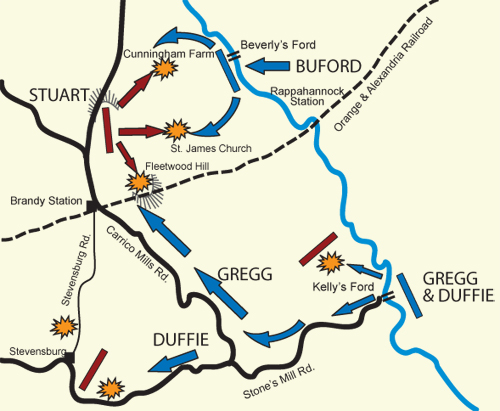Introduction
Following a brilliant yet costly victory at Chancellorsville in May 1863, Confederate General Robert E. Lee set his sights, and his army, on a second invasion of the North. In June 1863, Lee moved his army north toward Pennsylvania. To protect Lee’s infantry on this move, General J.E.B. Stuart’s cavalry screened the army from a Federal attack. Beginning at Brandy Station on June 9, the cavalry engagements between Union and Confederate forces comprised a significant portion of the campaign, with Brandy Station being the largest cavalry battle of the war. There was more fighting as the armies moved north at Aldie, Middleburg, and Upperville.
Stuart’s cavalry screen allowed Lee to successfully maneuver his men into Pennsylvania where on July 1-3, 1863, Lee’s men fought General George G. Meade’s Union army in a fierce battle that ended Lee’s second invasion. With almost 160,000 troops engaged and 51,000 casualties, the Battle of Gettysburg was the largest battle of the Civil War and one that sent Lee retreating southward.
After Gettysburg, Lee again called on Stuart’s cavalry to shield his troops as they raced toward the Potomac River before Meade could catch them. Although Lee slipped across the river, Meade tried to cut him off but failed after fighting at Manassas Gap.
Battle Of Brandy Station
Date: June 9, 1863
Result: Inconclusive
Troops Engaged: 11,000 US; 9,500 CS
Casualties: 936 US; 523 CS
On June 9, 1863, the war’s largest cavalry battle occurred at Brandy Station, involving 9,500 Confederate and 8,000 Union horsemen. The battle began when General Alfred Pleasonton’s Federal cavalry units crossed the Rappahannock River at Beverley’s Ford and Kelly’s Ford, attacking Stuart’s surprised Confederates. General John Buford led the 4:30 a.m. charge across Beverly’s Ford, forcing Southern horsemen to ride “into the fray partially dressed and often riding bareback.” Buford’s men engaged Stuart’s at the nearby Cunningham farm, St. James Church, and Yew Ridge. As the Federals gained ground near Yew Ridge, the Confederates began pulling back, “to the amazement of Buford’s men.” They had been forced to shift positions to meet General David Gregg’s horsemen arriving from Kelly’s Ford.
Gregg met little resistance at Kelly’s Ford and took some time arriving at Brandy Station; some of Gregg’s men never arrived on the battlefield, delayed by Confederates at Stevensburg, where Duffie was ordered to hold his position. Those who reached the field immediately engaged the enemy at Fleetwood Hill. A series of confusing charges and countercharges swept back and forth across the hill. When the battle finally ended, Confederate cavalry still held the field, but could not pursue their advantage. The Union forces re-crossed the Rappahannock at Beverley’s Ford and Rappahannock Station to their camps in Fauquier. The Confederates, however, had managed to prevent the Union cavalry from learning the intentions of General Robert E. Lee, who had begun marching his infantry to the Shenandoah Valley to invade the north.
BRANDY STATION TODAY
Most of this battle occurred in Culpeper County where important parcels of hallowed ground, such as St. James plain and Cunningham Farm, are being preserved by the Civil War Preservation Trust, Brandy Station Foundation, and other preservation organizations. Kelly’s Ford, a Union crossing point from Fauquier to Culpeper County, is about 300 yards downstream from the modern-day bridge across the Rappahannock River. Beverley’s Ford, another Union crossing spot, is located six miles upstream from Kelly’s Ford.

